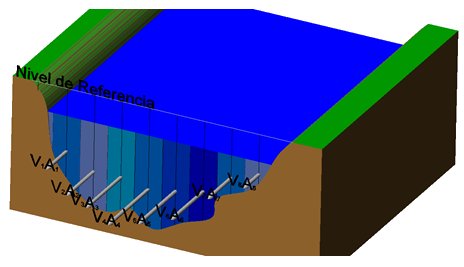For better visibility of the equations, it is suggested to place the white background
Introduction:
The speed section method is another procedure, used to determine the point flow in a river, at a certain time; as such, this value only tells us the flow rate that is happening at that precise moment, but by means of indirect methods a series of data can be determined, in which they can be used in a study of water resource availability in a specific basin and so in this way, determine the probability of occurrence of a given value expressed in the flow duration crow.
As is known, any measured value has an error related to the way it was determined and it is important to know it to determine the uncertainty of the value found, thus determining the value of the data.
In this publication I will show the Absolute and Relative Error committed when using this measurement method, in subsequent publications I will show the errors of other methods used.
Method section speed.
The procedure is based on measuring the velocity of water in certain sections in a given section of the river, as large "differentials" and then be weighted, this method is called a weighted graph.


The exact speed determination is done with a windlass or electromagnetic equipment, which measures the speed of the current at a given point; Depending on the size of causes it can be measured several times in the same vertical and several verticals in the section of the channel. You must determine a width that will depend on the size of the channel and its condition.
The above equation can be expressed as follows for the velocity section method:
 (1)
(1)
Error Determination:
To determine the absolute error, two traditionally known methods are used, the partial derivative method, where it expresses that the total error is the sum of the partial errors and the rule of propagation of the uncertainties.
Partial Derivatives Method:
But:

so:

If we apply differential:

Then:

Substituting in II:

Variable units:

Variable error:

It will depend on equipment used.

This error will be considered for the assessment at the time of measurement.

In the same way as the previous one.
Type B method or rule of propagation of uncertainties:
Applying the method, we have:

Calculation example:
The values shown are actual measured and determined in the field.
For the partial derivatives method:

Relative Error:


For the rule of uncertainty propagation rule:
Using the same values from the previous example:


Applying the triangular symmetric distribution criterion and with a broadening factor Ke = 2 corresponding to a 95% confidence level, we apply the equation (2)


Relative Error:


Conclusions:
It was determined that the errors of the method vary between 10% and 20% depending on the size of the channel.
It can be asserted that the method of section velocity in a method of relative precision, where the greatest error committed is in the determination of the necessary lengths and the lowest in the speeds, but that will depend on the equipment used, highlighted that the equipment used On this occasion 0.001 m / s is very accurate.
Practically the biggest errors are contained in the determination of the variables L and H, with 47% and 51% respectively.
The method of speed section in a method that requires entering the river bed, this merits having all the necessary equipment to perform such work, in addition to depending on the conditions of the moment for its determination.
The time spent in the method is longer compared to other methods and will depend on the size of the channel; it was determined that on average one hour is required to apply the method in a medium-sized river.
Bibliographic references.
[1] Amisial Rojas, 1975, Disponibilidad de agua superficial. CIDIAT, Mérida, Venezuela.
[2] Duque R., Bandes T. 1983. Estadística aplicada a la hidrología. (Elaborado por CIDIAT). Mérida, Venezuela.
[3] Bertrand-krajewski J., Laplace D., 1997. Mesures en hydrologie urbaine et assainissement. Editions TEC & DOC, Paris, Francia. 91 – 109 pp.




 (1)
(1)  (1)
(1)  so:
so:




 It will depend on equipment used.
It will depend on equipment used. This error will be considered for the assessment at the time of measurement.
This error will be considered for the assessment at the time of measurement. In the same way as the previous one.
In the same way as the previous one.









Congratulations @necho41! You have completed the following achievement on the Steem blockchain and have been rewarded with new badge(s) :
You can view your badges on your Steem Board and compare to others on the Steem Ranking
If you no longer want to receive notifications, reply to this comment with the word
STOPTo support your work, I also upvoted your post!
Nice equations :)
Yes, they look good! I see that the articles presented in steemstem do not present the equations well and that is important.
This post has been voted on by the SteemSTEM curation team and voting trail. It is elligible for support from @curie and @minnowbooster.
If you appreciate the work we are doing, then consider supporting our witness @stem.witness. Additional witness support to the curie witness would be appreciated as well.
For additional information please join us on the SteemSTEM discord and to get to know the rest of the community!
Thanks for having used the steemstem.io app. This granted you a stronger support from SteemSTEM. Note that including @steemstem in the list of beneficiaries of this post could have yielded an even more important support.
Thanks for the support!